 |
Convert FLV to JPG/JPEG Sequence
|
JPG/JPEG is a commonly used method of lossy compression
for digital photography (image). The degree of compression can be adjusted, allowing
a selectable tradeoff between storage size and image quality. JPEG typically achieves
10:1 compression with little perceptible loss in image quality.
FLV to JPG/JPEG Converter Software converts FLV to JPG/JPEG
sequence files. So, you could get every frame image of FLV in
JPG/JPEG format. You can also set output frame rate and JPG/JPEG resolution in
the software. The output JPG/JPEG files look something like the following screen
shot.
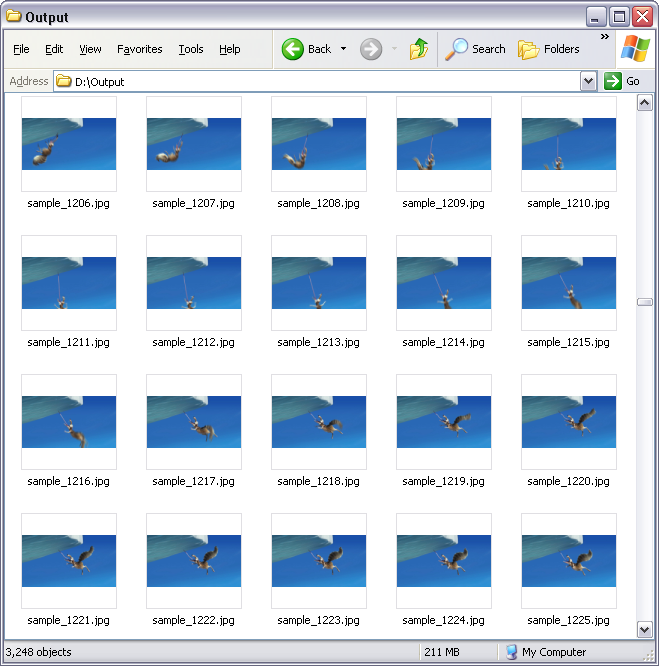
The software also supports other formats and portable devices such as DV, M4V, OGM, WAV, CAF (Core Audio Format), PNG image sequence, MKA,
etc. The software could convert DIVX to PPM image sequence, AVI to 3G2, MOD to PPM image sequence, 3G2 to Windows Phone, 3G2 to MKA, and so on.
FLV to JPG/JPEG Software supports batch conversion and, is compatible
with Windows 10/8/7/Vista/XP/2000.

What is FLV?
Flash Live Video (FLV) is a popular video format that displays videos at
very high qualities and is designed for web playback. This popular format
is used by many video-sharing websites such as Youtube, Metacafe and Google
video. The FLV format is an open format that is also supported by non-Adobe/Macromedia
programs. For example, F4V does not support Screen video, Sorenson Spark,
VP6 video compression formats and ADPCM, Nellymoser audio compression formats.
Starting with SWF files created for Flash Player 7, Flash Player can play
FLV file format directly (MIME type video/x-flv). Support for encoding
Flash Video files is provided by an encoding tool included with Adobe's
Flash Professional and Creative Suite products, On2's Flix encoding tools,
Sorenson Squeeze, FFmpeg and other third party tools. It is the required
video compression format for Flash Player 6 and 7. The Flash Video FLV
file format supports two versions of a so called 'screenshare' (Screen
video) codec which is an encoding format designed for screencasts. Both
these formats are bitmap tile based, can be lossy by reducing color depths
and are compressed using zlib. The second version is only playable in Flash
Player 8 and newer. Originally introduced as "Shockwave Flash,"
the FLV movies are viewable on major computer operating systems like Windows
and Macintosh. Flash Video FLV files usually contain material encoded with
codecs following the Sorenson Spark or VP6 video compression formats. Use
of the H.264 and AAC compression formats in the FLV file format has some
limitations and authors of Flash Player strongly encourage everyone to
embrace the new standard F4V file format.
What is JPG?
JPEG (usually pronounced JAY-pehg) is also a term for any graphic image
file produced by using a JPEG standard. A JPEG file is created by choosing
from a range of compression qualities (actually, from one of a suite of
compression algorithms). Very low and very high compression rates are supported
in JPEG 2000. The ability of the design to handle a very large range of
effective bit rates is one of the strengths of JPEG 2000. For example,
to reduce the number of bits for a picture below a certain amount, the
advisable thing to do with the first JPEG standard is to reduce the resolution
of the input image before encoding it. That is unnecessary when using JPEG
2000, because JPEG 2000 already does this automatically through its multiresolution
decomposition structure. Compared to the previous JPEG standard, JPEG 2000
delivers a typical compression gain in the range of 20%, depending on the
image characteristics. Higher-resolution images tend to benefit more, where
JPEG-2000's spatial-redundancy prediction can contribute more to the compression
process. In very low-bitrate applications, studies have shown JPEG 2000
to be outperformed by the intra-frame coding mode of H.264. Good applications
for JPEG 2000 are large images, images with low-contrast edges - e.g.,
medical images. JPEG standards are formally named as Information technology
- Digital compression and coding of continuous-tone still images. Now,
it takes longer to decode and view a JPEG image than to view an image of
a simpler format such as GIF. Thus using JPEG is essentially a time/space
tradeoff: you give up some time in order to store or transmit an image
more cheaply. But it's worth noting that when network transmission is involved,
the time savings from transferring a shorter file can be greater than the
time needed to decompress the file.
How to Convert FLV to JPG/JPEG Sequence?
- Free Download FLV to JPG/JPEG
Converter Software
- Install the Program by Step-by-step Instructions
- Launch FLV to JPG/JPEG Software
- Choose FLV Files

Click "Add Files" to choose FLV files.

Choose one or more FLV files you want to convert and then click Open.
FLV to JPG/JPEG Software will open FLV files and get file information
of the file such as width, height, frame rate, video bit rate, audio sample rate,
audio bit rate, audio channels, and then display the information of FLV file
at conversion list.
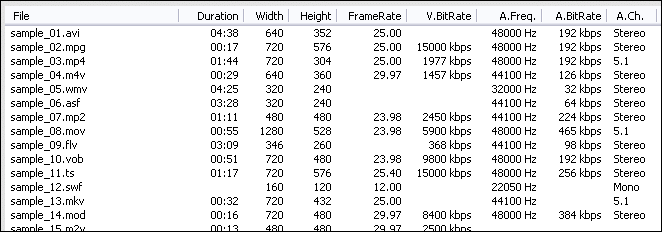
- Choose Output Format
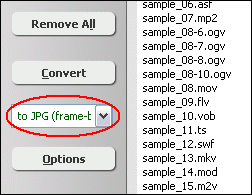
Click on combo-box of output format and then choose "to JPG (image sequence)".
- [Optional, for advanced user]
Set JPG Encoding Parameters
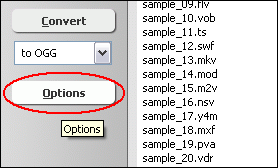
If you want to change JPG encoding parameters such as frame rate, video size,
aspect ratio, and so on, please click "Options".

And then, switch to tab "Video & Audio" and choose "JPG
(image sequence)" at "Output Format", and then set options
for image encoding.
- Convert FLV to JPG/JPEG
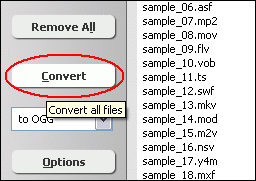
Click "Convert" to convert FLV to JPG/JPEG sequence.

The software is converting FLV files to JPG/JPEG.
- View and Browse JPG/JPEG Files
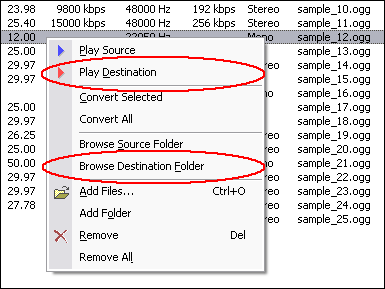
When conversion completes, you can right-click converted item and choose "Play
Destination" to view the first outputted JPG file; or choose "Browse
Destination Folder" to open Windows Explorer to browse the outputted JPG
files.
- Done
Top
FLV to JPG/JPEG Software is 100% clean and safe to
install. It's certified by major download sites.

Convert FLV to JPG/JPEG Related Topics:
|












